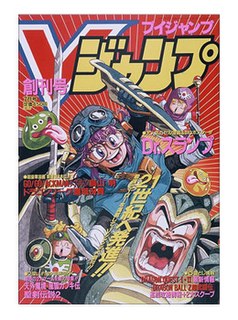
Akira Toriyama is a Japanese manga artist, game artist and character designer. He first achieved mainstream recognition for his highly successful manga series Dr. Slump, before going on to create Dragon Ball—his best-known work—and acting as a character designer for several popular video games such as the Dragon Quest series, Chrono Trigger and Blue Dragon. Toriyama is regarded as one of the artists that changed the history of manga, as his works are highly influential and popular, particularly Dragon Ball, which many manga artists cite as a source of inspiration.

Shōnen, shonen, or shounen manga is manga aimed at a teen male target-demographic readership. The age group varies with individual readers and different magazines, but it is primarily intended for boys between the ages of 12 to 18. The kanji characters (少年) literally mean "boy", and the characters (漫画) means "comic". Thus, the complete phrase means "young person's comic", or simply "boys' comic"; its female equivalent is shōjo manga. Shōnen manga is the most popular form of manga.

Hikaru no Go is a Japanese manga series based on the board game Go, written by Yumi Hotta and illustrated by Takeshi Obata. The production of the series' Go games was supervised by Go professional Yukari Umezawa. It was serialized in Weekly Shōnen Jump from 1999 to 2003, with the chapters collected into 23 tankōbon volumes by Shueisha.

Kazuki Takahashi is a Japanese manga artist and game creator, best known for creating Yu-Gi-Oh!.

Akira, often stylized as AKIRA, is a Japanese manga series written and illustrated by Katsuhiro Otomo. Initially serialized in the pages of Young Magazine from 1982 until 1990, the work was collected into six volumes by its publisher Kodansha. The work was published in the United States by Marvel Comics under their Epic Comics imprint, becoming one of the first manga works to be translated in its entirety into English. Otomo's art is considered outstanding, and a watershed for both Otomo and the manga form.
Masashi Kishimoto is a Japanese manga artist, well known for creating the manga series Naruto which was in serialization from 1999 to 2014. As of October 2015, the Naruto manga has sold over 220 million copies worldwide. The series has been adapted into two anime and multiple films, video games, and related media. Besides the Naruto manga, Kishimoto also personally supervised the two canonical anime films, The Last: Naruto the Movie and Boruto: Naruto the Movie, and has written several one-shot stories.

Weekly Shōnen Magazine is a weekly shōnen manga anthology published in Japan by Kodansha, first published on March 17, 1959. The magazine is mainly read by an older audience, with a large portion of its readership falling under the male high school or college student demographic. According to circulation figures accumulated by the Japanese Magazine Publishers Association, circulation of the magazine has dropped in every quarter since records were first collected in April–June, 2008. This is however, not an isolated occurrence as digital media continues to be on the rise.
Gangan is a manga imprint of Square Enix Holdings. It originated as a manga imprint for Enix before the company re-branded as Square Enix. It publishes manga in several magazines aimed at different reader demographic groups in the Japanese market. Its magazines are home to some popular manga series which were adapted into anime series, like Fullmetal Alchemist, Moribito: Guardian of the Spirit, Nabari no Ou, Inu x Boku SS, and Soul Eater. The comics are later collected in paperback volumes under brand names such as Gangan Comics, Gangan Comics Joker and Young Gangan Comics, which identify the magazine of serialisation. These paperback brand names are formed by deleting any Gekkan or Shōnen in the magazine name and inserting Comics directly after the word "Gangan".

V Jump is a Japanese manga magazine, focusing on new manga as well as video games based on popular manga. The magazine's debut was in 1993 by Shueisha under the Jump line of magazines.

Tokuma Shoten Publishing Co., Ltd. is a publisher in Japan, headquartered in Shinagawa, Tokyo. The company was established in 1954 by Yasuyoshi Tokuma in Minato, Tokyo. The company’s product portfolio includes music publishing, video game publishing, movies, anime, magazines, manga and books.

Akira Amano is a Japanese mangaka known for the shōnen series Reborn!.
Ryu Fujisaki is a Japanese manga artist from Mutsu, Aomori Prefecture.

Weekly Shōnen Big Comic was a bi-weekly manga magazine published by Shogakukan in Japan from 1979 to 1987. From 1976 to 1979, the magazine was titled Manga-kun (マンガくん) before being renamed Shōnen Big Comics in 1979.

Takeshi Yamamoto is a fictional character in the Reborn! manga and anime series created by Akira Amano. Portrayed as one of the protagonist's first friends, Takeshi Yamamoto is introduced as a 14-year-old starting pitcher for his school's baseball team. Apart from the manga and anime, Yamamoto has also appeared in other media from the Reborn! franchise including video games.

Shiki is a horror novel by Japanese novelist Fuyumi Ono. It was originally published in two parts by Shinchosha in 1998, it was then reprinted into five parts in 2002. A manga series adapting the story, drawn by Ryu Fujisaki was serialized in the Japanese monthly magazine Jump SQ. from December 2007 to June 2011. An anime adaptation of the manga by Daume began broadcasting on July 8, 2010 on Fuji Television and concluded later that year on December 30, 2010. North American anime distributor Funimation Entertainment simulcasted the series on their online video portal and released the series on DVD & Blu-ray on May 29, 2012.
Hatsukoi Scandal is a Japanese manga series by Akira Oze. It won the award for best shōnen manga at the 31st Shogakukan Manga Award. It was adapted into a TV special in 1986.

Akira Toriyama's Manga Theater is a series of three manga tankōbon released between 1983 and 1997 that collect several one-shots written and illustrated by Akira Toriyama. The stories were originally published in various Shueisha magazines between 1978 and 1994.
![Manga comics or [[graphic novel]]s created in Japan](https://upload.wikimedia.org/wikipedia/commons/thumb/7/75/Manga_in_Jp.svg/220px-Manga_in_Jp.svg.png)














